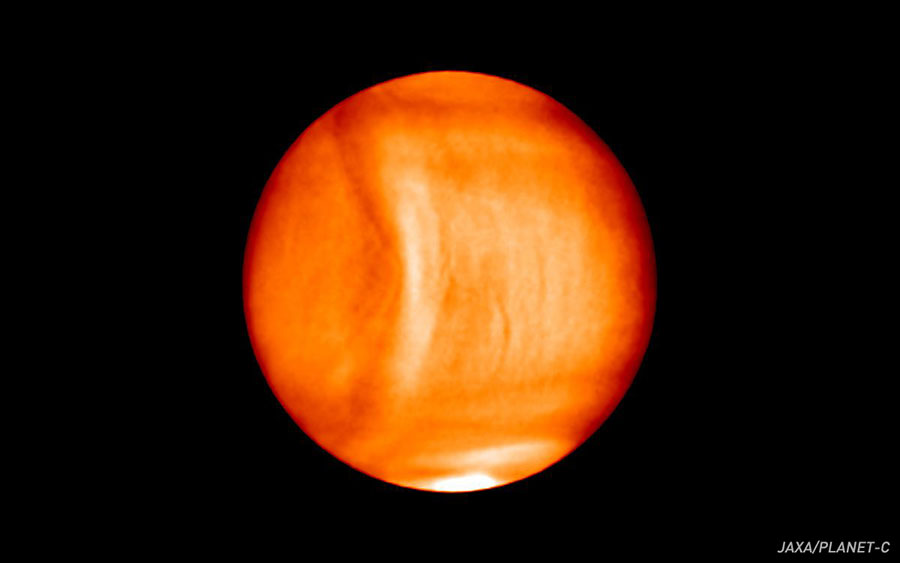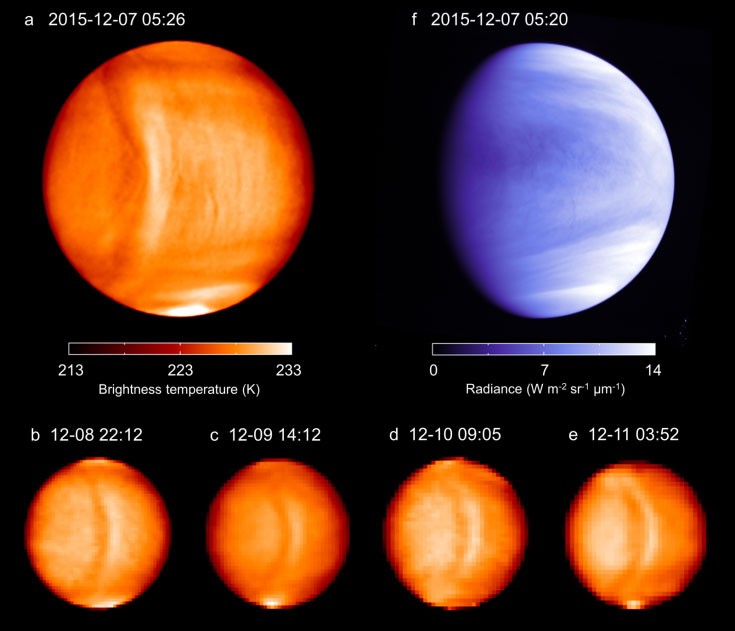JAXA Akatsuki probe captured a massive wave all over Venus’ atmosphere. The anomaly is called stationary gravity wave, and it hovers about 40 miles (65 kilometers) about the surface of Earth’s neighbor. According to the Japanese scientists, it lasts from one to three Earth days, then the giant wave vanishes.
The gravity wave is not visible to the human eye, but if we could see it on our planet, it would seem like a series of ripples in clouds that stretch all the way from one pole to the other. The wave in Venus is composed of sulfuric acid, and it goes at a constant speed of 220mph. The scientific community can’t give an exact explanation for the phenomenon yet.

“It’s very bizarre. It has no evident explanations,” Thomas Widemann, a planetary scientist at the Paris Observatory who wasn’t involved with the new study, told Business Insider. “It’s a surprise for all of us.”
The greatest gravity wave ever captured in the solar system
Though this wave on Venus has shocked scientists, gravity waves are not something strange to them. They are ripples of water vapor and ice that goes through the clouds. They take place when warm expanding air rises. Then the air cools becoming denser, and it falls back thanks to gravitational forces. Earth has gravity waves, though there are not as big as Venus’.
“The layers that make up the atmosphere change temperature and pressure as you rise or fall. When one of the layers hits something (say, a mountain), they push up against it — but gravity pulls them back down. The effect ripples through the other layers, creating waves all the way down” explains writer Sarah Kramer.
Scientists say that gravity waves can be formed by disturbances in the air like thunderstorms. As well, the waves can intensify storm or even generate tornadoes. But though they understand gravity waves they don’t know yet how they occur in Venus.
Understanding this phenomenon on Venus could help scientists to know more about our mysterious neighbor. Venus’ atmosphere is thick, as well the conditions of the planet make it harder for scientists to understand this planet. In fact, Japan Aerospace Exploration Agency (JAXA)’s Akatsuki spacecraft was the only one studying Venus.
Its mission started in December 2015 taking pictures. And that is how they noticed this strange wave in the cloud tops. They used an infrared light, a form of “heat visions,” to capture the anomaly. This is far bigger than any other gravity wave observed in the solar system.
This massive gravitation wave goes practically from the planet’s north pole to its south pole. It contains sulfuric acid. The Japanese scientists analyzed data for over a year, and they said that it starts about a mountain highland about 2.5 miles tall.

Venus is a mystery to scientists
Venus and Earth are two very different places. In here, our gravity waves are smaller because of our comfortably dense atmosphere. But Venus’, though it is a rocky planet too, has a highly dense atmosphere and persistent clouds that make it hard for scientists to keep track on it.
On Venus’ surface, the air is nearly 97 percent carbon dioxide, which is 100 times thicker than in Earth. It is incredibly hot, with about 864 degrees Fahrenheit (462 degrees Celsius), which is hot enough to melt us immediately, and it is also the reason why almost no mission is sent there.
The spacecraft can’t survive more than a couple of hours in Venus. Nasa had a chance to fund an orbiter and a lander for a mission in Venus – including a telescope to watch near-earth asteroids – but decided two missions to study distant asteroids over returning to Venus.
However, this discovery could drive the entire scientific community to revisit their views of the planet’s atmosphere. Evidence of gravity waves has been seen in Venus before, thanks to the data collected by the European Space Agency’s Venus Express mission, which ended in 2015.
Researchers have also used radar data from NASA’S Magellan mission (which ended in 1994) to understand the waves. According to Dr. Wilson, Venus Express had a different orbit where it got images of the poles but not of the low latitudes. Therefore it never saw features like the ones revealed by the spacecraft from JAXA.
He said as well that it was a glorious discovery for the ones working on the Venus Express data because is a confirmation of what they suggested from Venus data.
Source: Business Insider
